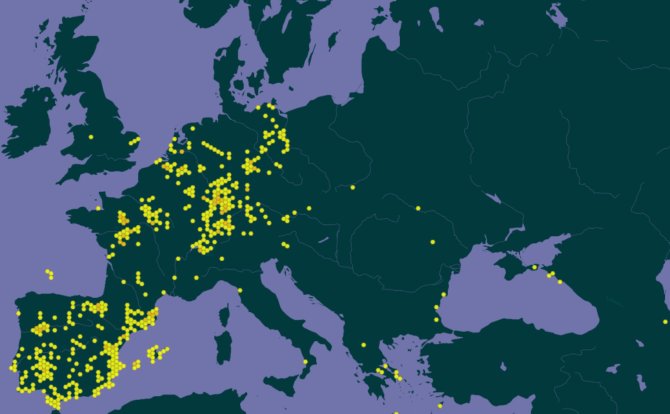
Project
Parasitic plants in European agriculture
Parasitic plants are plants feeding on other plants. When these plants invade crops they can become serious weed problems. The crops most threatened by parasitic weeds in Europe are sunflower, tomato, faba bean and oilseed rape. Currently most affected are the central and southern parts of Europe, but this is likely to change in the future. The aims of this project are to (1) assess whether parasitic weeds are expanding their distribution in northern direction, (2) identify parasitic weed species that encompass the highest future threat and (3) predict locations and crops at highest risk. Through a combination of analysis and mapping of public online data of observed presences, online farm surveys and ecological niche modeling the project will get a better understanding of the current and future distribution of parasitic plants in European agriculture.
Project description
Parasitic weeds encompass an increasing threat to crop production worldwide (Hegenauer et al., 2017). Crop damage due to parasitic weeds range from minor to complete yield losses, depending on infestation level, crop species and cultivar. In Europe the main parasitic weed species are broomrapes (Orobanche cumana, O. crenata, O. cernua and Phelipanche ramosa) and dodder (Cuscuta campestris) (Rubiales and Fernandez-Aparicio, 2012). The most affected regions in Europe are currently the Mediterranean (including France), the Balkan and Central Europe. Parasitic weeds are likely becoming more common and widespread in Europe. A range of drivers would be responsible for that, most importantly climate change, the transition to more diverse and sustainable cropping systems but also parasitic plant evolution. While there are currently about five real problematic and widespread parasitic weeds in European agriculture, there are at least 30 other species of parasitic plants, divided over 15 genera, that may become weed problems in the future. Climate change will likely push the frontiers of parasitic plant distributions to more northern parts of Europe. In addition, cropping systems become more diverse, offering a greater range of potential hosts to parasitic plants, while the increased use of seed mixtures for cover cropping or diversified field margins may introduce new parasitic plant species.
References: Hegenauer et al., 2017. Current Opinion in Plant Biology 38, 34-41; Rubiales & Fernandez-Aparicio, 2012. Agronomy for Sustainable Development 32, 433-449

Rights: GBIF.org (10 October 2024) GBIF Occurrence Download
https://doi.org/10.15468/dl.wvtwjh
Objectives and methods
This project will determine the past, current and future distributions of parasitic weeds in Europe to assess whether some species are spreading, as a result of changes in climate or cropping practices, and therefore form a potential threat to future crop production.
The study will follow a three-pronged approach:
- Public published data and information sources (including scientific literature and public online herbaria) will be searched and used for the construction of a
European parasitic weed species database. Using the collection years of
herbarium specimen or observations, current species distributions will be
mapped (following Rodenburg et al., 2016) and compared with historic
distributions to identify increases and directions of distribution. Along with the environmental variables that characterize those locations (e.g. crop type,
climate, soil) that should provide a first level of risk assessment. - An online survey will be done among arable farmers in a selection of NW European countries (e.g., France, Belgium, Netherlands, Germany, Denmark, UK) aimed at understanding awareness of parasitic weeds, past and current presence of species and perceived or incurred yield losses in NW European farms.
- Ecological niche modelling will be applied to model the current distribution, and subsequently combined with two likely climate scenarios to assess theoretical future distributions, similarly to Piwowarczyk and Kolanowska (2023).
Interpretations of all three approaches will be used to come up with a broad evidence base on the current and future importance of parasitic weeds in Europe.
References:
Piwowarczyk & Kolanowska, 2023. Global Ecology and Conservation 44, e02486; Rodenburg et al., 2016. Agr Ecosyst Environ 235, 306-317
Expectations
The project will be primarily desk based and involve working with data bases and conducting ecological niche modeling. The student can work on one, two or all three of the methodological components, depending on the number of ECTs, interests and level of the student.
Required skills
- Plant ecology knowledge and interest
- Affinity with and knowledge about crop and weed ecology
- A good background in statistics would be an asset
- Affinity or experience with spatial modeling would be an asset
- Academic writing skills
Types of research/work
This research is mainly on data science, biometry (basic
qualitative and quantitative statistics) and (spatial/ecological) modeling within
the context of plant/weed ecology research.
Period
This project can start at any given time.
Location
This is mainly a desk study, which is carried out at CSA, Radix Nova, Wageningen Campus